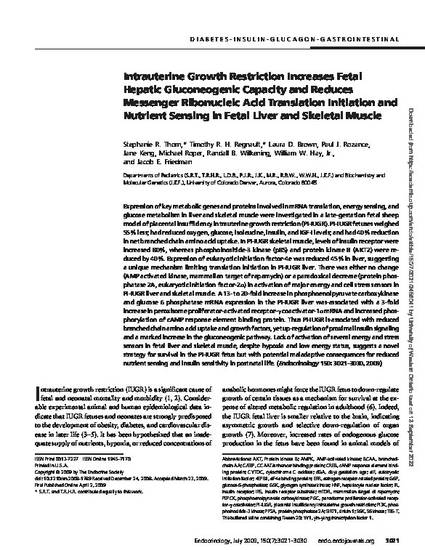
Expression of key metabolic genes and proteins involved in mRNA translation, energy sensing, and glucose metabolism in liver and skeletal muscle were investigated in a late-gestation fetal sheep model of placental insufficiency intrauterine growth restriction (PI-IUGR). PI-IUGR fetuses weighed 55% less; had reduced oxygen, glucose, isoleucine, insulin, and IGF-I levels; and had 40% reduction in net branched chain amino acid uptake. In PI-IUGR skeletal muscle, levels of insulin receptor were increased 80%, whereas phosphoinositide-3 kinase (p85) and protein kinase B (AKT2) were reduced by 40%. Expression of eukaryotic initiation factor-4e was reduced 45% in liver, suggesting a unique mechanism limiting translation initiation in PI-IUGR liver. There was either no change (AMP activated kinase, mammalian target of rapamycin) or a paradoxical decrease (protein phosphatase 2A, eukaryotic initiation factor-2 alpha) in activation of major energy and cell stress sensors in PI-IUGR liver and skeletal muscle. A 13- to 20-fold increase in phosphoenolpyruvate carboxykinase and glucose 6 phosphatase mRNA expression in the PI-IUGR liver was-associated with a 3-fold increase in peroxisome proliferator-activated receptor-gamma coactivator-1 alpha mRNA and increased phosphorylation of cAMP response element binding protein. Thus PI-IUGR is-associated with reduced branched chain amino acid uptake and growth factors, yet up-regulation of proximal insulin signaling and a marked increase in the gluconeogenic pathway. Lack of activation of several energy and stress sensors in fetal liver and skeletal muscle, despite hypoxia and low energy status, suggests a novel strategy for survival in the PI-IUGR fetus but with potential maladaptive consequences for reduced nutrient sensing and insulin sensitivity in postnatal life.
Available at: http://works.bepress.com/timothy-regnault/47/
